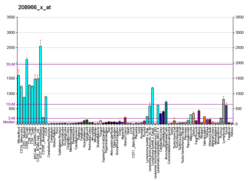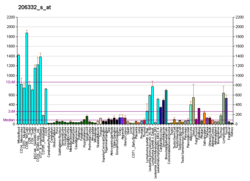Gamma-interferon-inducible protein Ifi-16 (Ifi-16) also known as interferon-inducible myeloid differentiation transcriptional activator is a protein that in humans is encoded by the IFI16 gene.[5][6][7]
Function
[edit]This gene encodes a member of the HIN-200 (hematopoietic interferon-inducible nuclear antigens with 200 amino acid repeats) family of cytokines. The encoded protein contains domains involved in DNA binding, transcriptional regulation, and protein-protein interactions. The protein localizes to the nucleoplasm and nucleoli, and interacts with p53.[8] It modulates p53 function, and inhibits cell growth in the Ras/Raf signaling pathway.[7] IFI16 has been shown to play a role in the sensing of intracellular DNA[9] - a hallmark of virally infected cells - and has also been linked to the death of HIV-infected helper CD4 T cells by pyroptosis, a highly inflammatory form of programmed cell death.[10][11] Recently, it has been shown how IFI16, once extracellularly released, can induce inflammation upon TLR4 binding, acting as a DAMP.[12]
References
[edit]- ^ a b c GRCh38: Ensembl release 89: ENSG00000163565 – Ensembl, May 2017
- ^ a b c GRCm38: Ensembl release 89: ENSMUSG00000073491 – Ensembl, May 2017
- ^ "Human PubMed Reference:". National Center for Biotechnology Information, U.S. National Library of Medicine.
- ^ "Mouse PubMed Reference:". National Center for Biotechnology Information, U.S. National Library of Medicine.
- ^ Trapani JA, Browne KA, Dawson MJ, Ramsay RG, Eddy RL, Show TB, et al. (Oct 1992). "A novel gene constitutively expressed in human lymphoid cells is inducible with interferon-gamma in myeloid cells". Immunogenetics. 36 (6): 369–376. doi:10.1007/bf00218044. PMID 1526658. S2CID 1196925.
- ^ Trapani JA, Dawson M, Apostolidis VA, Browne KA (Dec 1994). "Genomic organization of IFI16, an interferon-inducible gene whose expression is associated with human myeloid cell differentiation: correlation of predicted protein domains with exon organization". Immunogenetics. 40 (6): 415–424. doi:10.1007/bf00177824. PMID 7959953. S2CID 2602156.
- ^ a b "Entrez Gene: IFI16 interferon, gamma-inducible protein 16".
- ^ Ouchi M, Ouchi T (January 2008). "Role of IFI16 in DNA damage and checkpoint". Frontiers in Bioscience. 13 (13): 236–239. doi:10.2741/2673. PMID 17981541.
- ^ Unterholzner L, Keating SE, Baran M, Horan KA, Jensen SB, Sharma S, et al. (November 2010). "IFI16 is an innate immune sensor for intracellular DNA". Nature Immunology. 11 (11): 997–1004. doi:10.1038/ni.1932. PMC 3142795. PMID 20890285.
- ^ Monroe KM, Yang Z, Johnson JR, Geng X, Doitsh G, Krogan NJ, et al. (January 2014). "IFI16 DNA sensor is required for death of lymphoid CD4 T cells abortively infected with HIV". Science. 343 (6169): 428–432. Bibcode:2014Sci...343..428M. doi:10.1126/science.1243640. PMC 3976200. PMID 24356113.
- ^ Doitsh G, Galloway NL, Geng X, Yang Z, Monroe KM, Zepeda O, et al. (January 2014). "Cell death by pyroptosis drives CD4 T-cell depletion in HIV-1 infection". Nature. 505 (7484): 509–514. Bibcode:2014Natur.505..509D. doi:10.1038/nature12940. PMC 4047036. PMID 24356306.
- ^ Iannucci A, Caneparo V, Raviola S, Debernardi I, Colangelo D, et al. (2020) Toll-like receptor 4-mediated inflammation triggered by extracellular IFI16 is enhanced by lipopolysaccharide binding. PLOS Pathogens 16(9): e1008811. https://doi.org/10.1371/journal.ppat.1008811
Further reading
[edit]- Dawson MJ, Trapani JA (January 1995). "IFI 16 gene encodes a nuclear protein whose expression is induced by interferons in human myeloid leukaemia cell lines". Journal of Cellular Biochemistry. 57 (1): 39–51. doi:10.1002/jcb.240570106. PMID 7536752. S2CID 3007802.
- Dawson MJ, Trapani JA, Briggs RC, Nicholl JK, Sutherland GR, Baker E (1995). "The closely linked genes encoding the myeloid nuclear differentiation antigen (MNDA) and IFI16 exhibit contrasting haemopoietic expression". Immunogenetics. 41 (1): 40–43. doi:10.1007/BF00188431. PMID 7806273. S2CID 12788123.
- Johnstone RW, Kerry JA, Trapani JA (July 1998). "The human interferon-inducible protein, IFI 16, is a repressor of transcription". The Journal of Biological Chemistry. 273 (27): 17172–17177. doi:10.1074/jbc.273.27.17172. PMID 9642285.
- Johnstone RW, Kershaw MH, Trapani JA (August 1998). "Isotypic variants of the interferon-inducible transcriptional repressor IFI 16 arise through differential mRNA splicing". Biochemistry. 37 (34): 11924–11931. doi:10.1021/bi981069a. PMID 9718316.
- Dawson MJ, Elwood NJ, Johnstone RW, Trapani JA (October 1998). "The IFN-inducible nucleoprotein IFI 16 is expressed in cells of the monocyte lineage, but is rapidly and markedly down-regulated in other myeloid precursor populations". Journal of Leukocyte Biology. 64 (4): 546–554. doi:10.1002/jlb.64.4.546. PMID 9766636. S2CID 40241172.
- Briggs LJ, Johnstone RW, Elliot RM, Xiao CY, Dawson M, Trapani JA, et al. (January 2001). "Novel properties of the protein kinase CK2-site-regulated nuclear- localization sequence of the interferon-induced nuclear factor IFI 16". The Biochemical Journal. 353 (Pt 1): 69–77. doi:10.1042/0264-6021:3530069. PMC 1221544. PMID 11115400.
- Johnstone RW, Wei W, Greenway A, Trapani JA (December 2000). "Functional interaction between p53 and the interferon-inducible nucleoprotein IFI 16". Oncogene. 19 (52): 6033–6042. doi:10.1038/sj.onc.1204005. PMID 11146555. S2CID 13273815.
- Gariglio M, Azzimonti B, Pagano M, Palestro G, De Andrea M, Valente G, et al. (July 2002). "Immunohistochemical expression analysis of the human interferon-inducible gene IFI16, a member of the HIN200 family, not restricted to hematopoietic cells". Journal of Interferon & Cytokine Research. 22 (7): 815–821. doi:10.1089/107999002320271413. hdl:2318/39497. PMID 12184920.
- Strausberg RL, Feingold EA, Grouse LH, Derge JG, Klausner RD, Collins FS, et al. (December 2002). "Generation and initial analysis of more than 15,000 full-length human and mouse cDNA sequences". Proceedings of the National Academy of Sciences of the United States of America. 99 (26): 16899–16903. Bibcode:2002PNAS...9916899M. doi:10.1073/pnas.242603899. PMC 139241. PMID 12477932.
- Izmailova E, Bertley FM, Huang Q, Makori N, Miller CJ, Young RA, et al. (February 2003). "HIV-1 Tat reprograms immature dendritic cells to express chemoattractants for activated T cells and macrophages". Nature Medicine. 9 (2): 191–197. doi:10.1038/nm822. PMID 12539042. S2CID 26145639.
- Clarke CJ, Apostolidis V, Hii LL, Gough DJ, Trapani JA, Johnstone RW (May 2003). "Critical role of the transcription factor AP-1 for the constitutive and interferon-induced expression of IFI 16". Journal of Cellular Biochemistry. 89 (1): 80–93. doi:10.1002/jcb.10475. PMID 12682910. S2CID 32678644.
- Xin H, Curry J, Johnstone RW, Nickoloff BJ, Choubey D (July 2003). "Role of IFI 16, a member of the interferon-inducible p200-protein family, in prostate epithelial cellular senescence". Oncogene. 22 (31): 4831–4840. doi:10.1038/sj.onc.1206754. PMID 12894224. S2CID 21949316.
- Kwak JC, Ongusaha PP, Ouchi T, Lee SW (October 2003). "IFI16 as a negative regulator in the regulation of p53 and p21(Waf1)". The Journal of Biological Chemistry. 278 (42): 40899–40904. doi:10.1074/jbc.M308012200. PMID 12925527.
- Aglipay JA, Lee SW, Okada S, Fujiuchi N, Ohtsuka T, Kwak JC, et al. (December 2003). "A member of the Pyrin family, IFI16, is a novel BRCA1-associated protein involved in the p53-mediated apoptosis pathway". Oncogene. 22 (55): 8931–8938. doi:10.1038/sj.onc.1207057. PMID 14654789.
- Ota T, Suzuki Y, Nishikawa T, Otsuki T, Sugiyama T, Irie R, et al. (January 2004). "Complete sequencing and characterization of 21,243 full-length human cDNAs". Nature Genetics. 36 (1): 40–45. doi:10.1038/ng1285. PMID 14702039.
- Raffaella R, Gioia D, De Andrea M, Cappello P, Giovarelli M, Marconi P, et al. (February 2004). "The interferon-inducible IFI16 gene inhibits tube morphogenesis and proliferation of primary, but not HPV16 E6/E7-immortalized human endothelial cells". Experimental Cell Research. 293 (2): 331–345. doi:10.1016/j.yexcr.2003.10.014. hdl:2318/42932. PMID 14729471.
- Fujiuchi N, Aglipay JA, Ohtsuka T, Maehara N, Sahin F, Su GH, et al. (May 2004). "Requirement of IFI16 for the maximal activation of p53 induced by ionizing radiation". The Journal of Biological Chemistry. 279 (19): 20339–20344. doi:10.1074/jbc.M400344200. PMID 14990579.
- Beausoleil SA, Jedrychowski M, Schwartz D, Elias JE, Villén J, Li J, et al. (August 2004). "Large-scale characterization of HeLa cell nuclear phosphoproteins". Proceedings of the National Academy of Sciences of the United States of America. 101 (33): 12130–12135. Bibcode:2004PNAS..10112130B. doi:10.1073/pnas.0404720101. PMC 514446. PMID 15302935.
External links
[edit]- IFI16+protein,+human at the U.S. National Library of Medicine Medical Subject Headings (MeSH)
This article incorporates text from the United States National Library of Medicine, which is in the public domain.








